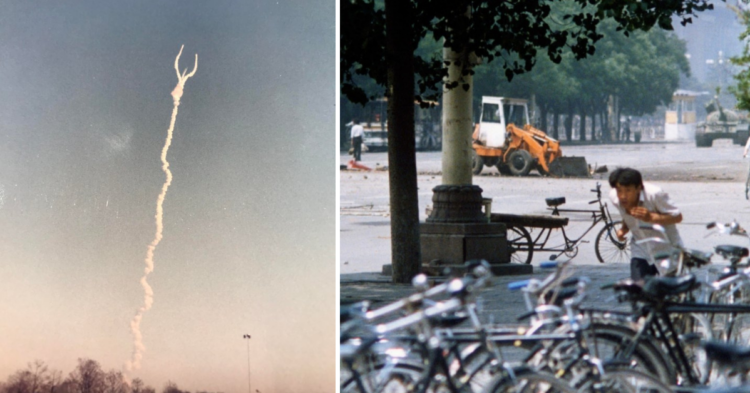Unless you were there for a major historical event, chances are your impression of that event is shaped almost entirely by the images captured from it. We’re all used to history looking a certain way. But there are always other perspectives, and sometimes they’re captured by photographers. Let’s look at history through a slightly different lens.
Going to the moon is an emotional experience.

There’s tons of imagery and footage of NASA’s various moon landings. But this shows a more intimate perspective: Neil Armstrong, bright-eyed (and a little teary-eyed), inside the lunar capsule as it sits on the surface of the moon.
An astronomical knockout.

This gorgeous top-down shot of Muhammad Ali’s knockout of Cleveland Williams in 1966 was made possible because the fight took place in a huge, enclosed stadium — Houston’s iconic Astrodome.
Behind military lines.

The Troubles, a period of sectarian violence, marred everyday life in Northern Ireland for years. Here we see British troops opening fire on Catholic protesters, killing 14 of them — from the perspective of the British troops.
A happy little mountain.

That vista looks familiar, right? It should, because it’s the original, hand-painted version of Paramount Pictures’ famous logo that runs before its movies. This shows the artist after he’d completed the work in 1965.
Flying away.

A presidential inauguration is a time of pomp and celebration for the incoming president. But for the outgoing president — in this case, George H.W. Bush — it’s a time for silent reflection as they leave Washington.
Did this iceberg sink the Titanic?

There’s no way of knowing for sure, but it did have a telltale scuff of red and black paint. Considering there are no photos of the sinking itself, this is as close as we can get.
Into the jaws of death.

This perspective shows just how terrifying it must have been to wade ashore at Juno Beach for D-Day and take on the entrenched Nazi forces. Thousands of soldiers were killed.
A WWII surrender…in 1974.

We’re used to seeing celebrating crowds in New York and London, or Allied forces rolling into Germany and Japan.
But for this stranded Japanese soldier, Hiroo Onoda, the war didn’t end until he was discovered by the outside world in 1974.
Things look…incomplete.
![Image credit: Reddit | [deleted]](https://static.diply.com/v8yQqQA01wzsa5BUcvPP.jpg)
The soaring towers are painted their trademark shade of International Orange, but the Golden Gate Bridge looks way different without the road deck and cables to stick it together. This was snapped during construction in 1934.
When the bloodshed is over.

This shows the USS Enterprise CV-6. During World War II, this aircraft carrier was covered with weaponry, fighter planes and military personnel. But by the late 1950s, it had served its purpose, and was pushed through New York Harbor on its way to the scrapyard.
Some warmth in the Cold War.

The fall of the Berlin Wall in 1989 is one of the most notable events of the 20th century. Before the wall was torn down by cheering crowds, quieter scenes like this existed: an East German guard passing a flower through a gap in the wall.
Pearl Harbor as it happened.

There are plenty of pics of the aftermath of the Pearl Harbor attacks, and even some shot from the air by Japanese airmen. But this image shows the chaos, as it happened, from the perspective of someone on the base.
This lesser known view taken from behind Martin Luther King as he delivered his now iconic “I Have A Dream” speech on August 28, 1963.

Seeing the thousands of protesters from this perspective makes the “March On Washington for Jobs and Freedom” all the more powerful.
A snapshot of tragedy.

The space shuttle Challenger broke apart on launch in 1986, killing all seven crewmembers. The launch was watched by many Americans — and, as a result, some snapshots like this exist showing the explosion from a different angle. “My mother took a photo of the Space Shuttle Challenger explosion,” wrote Reddit user Imconfusedclassic.
Jackie Kennedy watches on as her husband and presidential candidate John F. Kennedy debates with Richard Nixon in September of 1960.

It was the first presidential debate that was televised in what is now regarded as one of the most significant moments in American history, but in this picture — it’s a wife quietly supporting her husband in a private but powerful moment.
The end of the first war to end all wars.

These military officers are scrambling to get a good look at the signing of the Treaty of Versailles, happening in the room next door. The Treaty of Versailles officially brought WWI to a close, making a fragile, difficult peace that lasted for 20 years in Europe.
And what kicked it all off.

Archduke Franz Ferdinand was wearing this uniform when he was assassinated, the spark that ignited the powder keg of Europe.
What are the chances?

This incredible pic shows Tiananmen Square’s anonymous “Tank Man” standing down a row of tanks. Considering the fact that everybody else in the pic is running away, it says something that the photographer was able to capture this.
The first look at a disaster like the world had never seen before.

Of all the days that rightly live in infamy, April 26, 1986 is right up there. We’re still feeling the effects of the reactor explosion at Chernobyl power plant today.
A civilian in Southern France caught Allied landing ships making for the coast line in WWII.

The “lesser-known D-Day,” in which the Allies landed on the Mediterranean coast of France in August, 1944, opened up a second front as well as providing a new source of supplies for the troops already in France from the first D-Day. Whereas the Invasion of Normandy was known as Operation Overlord, the landing in Southern France was known as Operation Dragoon .
To the Moon and back.

We’re used to seeing the up-close launch pad view of Apollo 11 headed for the first manned mission to the surface of the Moon. This is what it looked like to observers nearby.
“Houston, we have a problem…”

Ron Howard’s movie pretty effectively caught the drama of an event that gripped the nation for several days in 1970, not even a year after the Apollo 11 moon landing. Here we see Neil Armstrong providing a calming presence while Apollo 13 commander Jim Lovell’s wife, Marilyn, frets in front of the TV.
Some assembly required.

Lady Liberty came to America in 350 pieces . To help pay for the statue’s construction and assembly, the chunks, including her head and her torch, were put on display at venues like the World’s Fair in Paris and the Centennial Exposition in Philadelphia.
The infamous Moulin Rouge nightclub in Paris.

If you’re only familiar with the Baz Luhrmann movie, this seems downright modest and humble, but back in the 19th century, it was probably pretty fun.
Facing forward.

America wouldn’t be quite the same without Mount Rushmore, would it? The monument is seen under construction here, with Lincoln’s head being carved out of the rock.
The amazing pace of advancement.

Just think of how far medical technology has come when you see pacemakers used to be external, like this.
















































